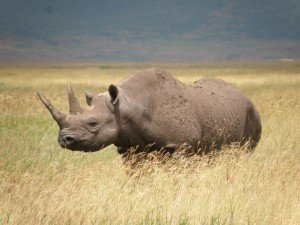The new International Union for Conservation of Nature (IUCN) warning that the wild black rhinoceros sub-species (Diceros bicornis longipes) is extinct in West Africa is a signal that Western conservationists should consider investing in breeding rhino in the wild, rather than in captive breeding projects at sites such as zoos, says a New Zealand researcher, Dr Wayne Linklater.
 The IUCN’s latest Red List said: ” Given the wildlife poaching taking place, lack of political will and conservation effort by Cameroon conservation authorities in the past, and increasing illegal demand for rhino horn and associated increased commercial rhino poaching in other range states, it is highly probable that this subspecies is now extinct”.
The IUCN’s latest Red List said: ” Given the wildlife poaching taking place, lack of political will and conservation effort by Cameroon conservation authorities in the past, and increasing illegal demand for rhino horn and associated increased commercial rhino poaching in other range states, it is highly probable that this subspecies is now extinct”.
It noted that another subspecies of northern white rhino (Ceratotherium simum cottoni), in central Africa is also possibly extinct, and the last Javan rhino (Rhinoceros sondaicus) in Vietnam had gone.
Dr Linklater has just returned from rhino conservation work in South Africa, and has had postgraduate students researching the behaviour and ecology of rhinoceros. They have worked with the Black Rhinoceros Range Expansion Project in KwaZulu Natal — a conservation project which has expanded to South Africa’s Eastern Cape and Limpopo Province in recent years.
Dr Linklater told the SMC:
“It is important that we re-focus on doing conservation in the wild. Populations can be protected from poaching to the point where species recovery with high breeding rates can even tolerate some poaching. It’s a case of putting the animals in situations where their fecundity and survival rates are high enough to cope with occasional poaching. That means putting them in good habitat in a multitude of sites.
“The money to protect rhino populations with paramilitary-style enforcement is relatively cheap compared with captive programmes, as are translocation programmes to put breeding animals into new parks. You can do more for rhino conservation than failing to breed them in captivity.
“It’s unfortunately true that captive programmes to rescue and breed rhino have performed very poorly – the real solution lies in management of the populations in the wild to protect them, and let them get on with what they do best. Captivity should only be regarded as a very last resort for rhino …the best course of action is to devote funds to wild populations”.
“I think it’s a mistake continue to invest in captive rhino programmes unless there’s absolutely no hope of protecting them in the wild. Rhino conservation is divided into two camps – those who do it in the wild and those who do in captivity. Those who do it in captivity are largely in western countries with big budgets — my concern is that they are attracitng important conservation investment that should be going into developing countries.There’s a 10 to 100-fold difference between the impacts you can have with the same money in the wild and in captivity”.
On the NZ research work underway, Dr Linklater said:
“Some important outbreeding for black rhino needs to occur. Genetic work appears to demonstrate some loss of diversity in remnant populations that may need to be addressed by outbreeding. We’re not clear whether that loss is a recent event, because of population decline or might be a historic pattern. We need to go back to museum specimens to check”.
“Other projects we have going on include gaining an understanding of what cronic impacts intrernal parasite infestation may have for rhinocerus breeding rates. A PhD student, Andrew Stringer, is in South Africa looking at testing some fundamental ecological theories about the role of habitat and host population density and co-host population density plays on parasite abundance. Maybe small reserves are particularly prone to high parasite burdens.
There is an interesting relationship between quality of habitat and how well the animals cope with a parasite burden. There are theories that some parasites are actually mutualists which innoculate the rhino against other parasites.”
Footage provided by IUCN with its latest update of the IUCN Red List of Threatened Species